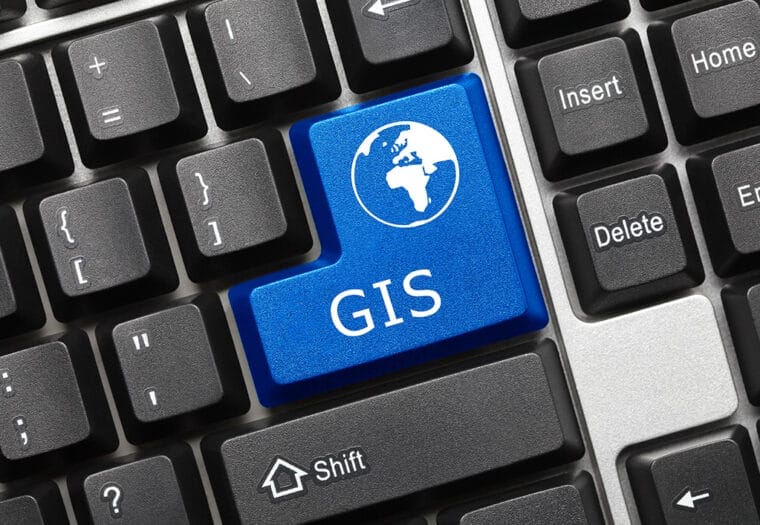News | Nov 15, 2023 | Anne Keener
Arora Celebrates National GIS Day
Arora Engineers is thrilled to join in the celebration of National GIS Day! This annual event is dedicated to honoring the incredible advancements in geographic information systems (GIS) technology. Established in 1999, this event was initiated by Esri, a leading provider of spatial analytics software. Today, National GIS Day has evolved into an international platform where professionals from various sectors within the GIS industry come together to showcase real-world applications that are driving positive changes in society.
At Arora, our Geospatial Practice is committed to offering a comprehensive suite of products and services that empower our clients to harness the potential of geospatial data and cutting-edge technologies. Our goal is to help our clients reduce costs and optimize the efficiency of their planning, design, operations, and maintenance endeavors.
From program planning and architectural design to data collection, application design, and support, our solutions are designed to assist our clients in boosting revenue, ensuring safety, achieving overall operational excellence, and staying compliant with regulatory requirements. Our team boasts expertise in BIM/CAD/GIS data development, application configuration, and seamless integration with third-party information systems. These capabilities result in solutions that encompass lease management, airspace analysis, asset management, utility locating, interior wayfinding, and FAA 18B data compliance.
Our dedicated team offers on-site and virtual consultation services to guide clients in envisioning their geospatial programs, leveraging existing data, IT infrastructure, and data management workflows, all aligned with predefined objectives and in collaboration with stakeholders. The outcomes are meticulously documented in a Geospatial Roadmap, categorizing tasks related to data, systems, and organizational governance. To gain further insights, we caught up with some of our GIS team members to understand what National GIS Day signifies to them:
How did you get into GIS?
 Benjamin Smith McRobie, GIS Specialist: “Knowing I wanted to work within the built environment I started my education as an architecture major. After taking a GIS elective course I fell in love with the ability to understand not only what happens on a site but also the surroundings in great detail. Shortly after I changed my major to a BS of Architectural Studies and continued with a Masters in GeoDesign. Every day I work on projects that help clients visualize and query their assets by creating intuitive and interactive maps and dashboards. One of my favorite GIS projects was a redesign of center city Philadelphia with environmental sustainability being a large part of the project. Using GIS software and skills, we were able to make reports including energy consumption and environmental impact. I’m continually blown away by how I see GIS appearing in more and more fields outside of Architecture/Engineering/Construction.”
Benjamin Smith McRobie, GIS Specialist: “Knowing I wanted to work within the built environment I started my education as an architecture major. After taking a GIS elective course I fell in love with the ability to understand not only what happens on a site but also the surroundings in great detail. Shortly after I changed my major to a BS of Architectural Studies and continued with a Masters in GeoDesign. Every day I work on projects that help clients visualize and query their assets by creating intuitive and interactive maps and dashboards. One of my favorite GIS projects was a redesign of center city Philadelphia with environmental sustainability being a large part of the project. Using GIS software and skills, we were able to make reports including energy consumption and environmental impact. I’m continually blown away by how I see GIS appearing in more and more fields outside of Architecture/Engineering/Construction.”
 Matthew Baker, GISP, GIS Specialist: “I found mapping of the environment to be amazing and very eye opening as to the damage that we are doing to the planet. I thought that it was so powerful to be able to show such large amounts of data in a meaningful way. You can take very complex situations and information and make them easy to understand for anyone. That to me is so powerful.”
Matthew Baker, GISP, GIS Specialist: “I found mapping of the environment to be amazing and very eye opening as to the damage that we are doing to the planet. I thought that it was so powerful to be able to show such large amounts of data in a meaningful way. You can take very complex situations and information and make them easy to understand for anyone. That to me is so powerful.”
What has been your favorite or most memorable GIS project?
 Tim Lesser, GISP, Sr. GIS Specialist: “There are many memorable projects, although most recently the Indoors project with FLL. Data with z-value elevations, such as floor plans of all the terminals, navigation pathways, transitions between floors, and points of interest (POIs) locations and content were developed for public wayfinding and informational access. We developed a mobile application for FLL that included the mapping of public facing floor plans with the POI locations, shop/dine concession content, and flight and parking information.”
Tim Lesser, GISP, Sr. GIS Specialist: “There are many memorable projects, although most recently the Indoors project with FLL. Data with z-value elevations, such as floor plans of all the terminals, navigation pathways, transitions between floors, and points of interest (POIs) locations and content were developed for public wayfinding and informational access. We developed a mobile application for FLL that included the mapping of public facing floor plans with the POI locations, shop/dine concession content, and flight and parking information.”
 Katherine Iles, Sr. GIS Specialist: “Working on the ArcGIS Indoors project for Atlanta Airport has been an exciting experience where I have had the opportunity to dive deep into developing the Indoors Information Model and create a suite of Indoors applications. These applications aid in the interior navigation, asset management and office assignment for the airport. This has been a monumental project in developing my skills.”
Katherine Iles, Sr. GIS Specialist: “Working on the ArcGIS Indoors project for Atlanta Airport has been an exciting experience where I have had the opportunity to dive deep into developing the Indoors Information Model and create a suite of Indoors applications. These applications aid in the interior navigation, asset management and office assignment for the airport. This has been a monumental project in developing my skills.”
Share a lesser-known fact about GIS that you find intriguing.
 Nelson Ahrens, GIS Analyst: “Back in the day when I used physical (paper) maps, it seemed intuitive to me that the only way an image from a spherical surface (e.g., globe) could be displayed on a flat surface, such as a paper map, distortion was inevitable. Like an inflated balloon with an image on it, once the balloon was deflated and laid flat the image would be distorted (stretched). However, as I started using electronic maps, I just assumed that the computer could negate any distortion. Once I started studying GIS, I was surprised to learn that there is still distortion, but GIS can lessen (distribute) the distortion.
Nelson Ahrens, GIS Analyst: “Back in the day when I used physical (paper) maps, it seemed intuitive to me that the only way an image from a spherical surface (e.g., globe) could be displayed on a flat surface, such as a paper map, distortion was inevitable. Like an inflated balloon with an image on it, once the balloon was deflated and laid flat the image would be distorted (stretched). However, as I started using electronic maps, I just assumed that the computer could negate any distortion. Once I started studying GIS, I was surprised to learn that there is still distortion, but GIS can lessen (distribute) the distortion.
Map distortion occurs in four ways: area, shape, distance, and direction and is directly proportional to the size of the mapped area (e.g., distortion for map of North America would be much greater than a map of North Carolina). GIS (electronic) maps utilize what are called projections to minimize distortion. Also, GIS can adjust distortion for specific purposes. For example, in a map needed for navigation (e.g., vehicular GPS, and aviation flight routing), GIS would heighten the precision of the direction and distance components (most critical for navigation) at the loss of precision (more distortion) in the shape and area components.
I imagine most people don’t appreciate how GIS provides precise maps (as accurate as possible). I still take all this for granted each time I get to my destination thanks to Waze.”
 Thomas Crossman, Sr. GIS Analyst: “Fundamentally, “GIS” does not mean a high-tech system that only a highly-trained, aloof professional can understand and operate. A GIS can be relevant to and creatable by anyone; think maps.
Thomas Crossman, Sr. GIS Analyst: “Fundamentally, “GIS” does not mean a high-tech system that only a highly-trained, aloof professional can understand and operate. A GIS can be relevant to and creatable by anyone; think maps.
Let’s say you have a simple paper map of soils in your town, consisting of an area divided by lines into a bunch of subareas, each subarea filled in with a color indicating the type of soil in that subarea. The map demonstrates that soil types vary over space, a fundamental property on which a GIS operates. So is the map a GIS? No, not in itself. It’s cartography (a powerful field of pursuit in its own right). Now, suppose you also have a paper map of the same area with several dots representing the known locations, coming from a few anecdotal reports from the public, of a particularly nasty invasive plant of great concern to your town. Someone looking at the plant map may observe: “OK, so these invasives are growing at these locations, but is that the only place they are? Probably not, but how can we be sure? We can’t go out and walk every square inch of the town looking for this thing. How do we know where to look?”
Another person may then have an idea—pointing at the map: “Well, why is the plant growing where it is? Does it prefer some particular habitat?” Then, “Wait a minute. Maybe it only grows in a particular type of soil … and we have a soil map right here. Let’s compare the maps.” After looking back and forth for a while, that person, not being able quite to make sense of the comparison, puts the plant map on top of the soil map … then frowns. The soil map isn’t visible: “What we need is a big light table, but we don’t have one here.” Then, she grabs both maps and runs to a big window. She tapes the soil map on the window and then tapes the plant map over it. Voila! Both maps are visible. Someone else observes: “The dots for the plants are only in these two soil colors. Maybe we only have to look in areas with these two soil types.” Now do we have a GIS? Yes, indeed. The superimposed maps have revealed a pattern, and the map users have a working solution … all accomplished with two pieces of paper, a window, and some tape.
A GIS is fundamentally any system that layers different kinds of information by literally lining them up in space. This natural spatial correspondence can reveal patterns that can be both fascinating and informative to problem solving.”
What aspects of your work with GIS do you find most fulfilling?
 Marco Viola, Vice President, Global Business Development, Enterprise Solutions: “One of the most fulfilling aspects of my work with GIS is witnessing the transformative realization among individuals at the organizations we collaborate with. Many come with little to no knowledge of GIS, often viewing data in traditional, tabular formats. However, once they experience the power of GIS, there’s an undeniable shift. They become captivated by this ‘new’ way of visualizing data, seeing patterns and connections that were previously hidden. It’s incredibly rewarding to see how GIS not only enhances their understanding but often ignites a newfound passion for data-driven decision-making.”
Marco Viola, Vice President, Global Business Development, Enterprise Solutions: “One of the most fulfilling aspects of my work with GIS is witnessing the transformative realization among individuals at the organizations we collaborate with. Many come with little to no knowledge of GIS, often viewing data in traditional, tabular formats. However, once they experience the power of GIS, there’s an undeniable shift. They become captivated by this ‘new’ way of visualizing data, seeing patterns and connections that were previously hidden. It’s incredibly rewarding to see how GIS not only enhances their understanding but often ignites a newfound passion for data-driven decision-making.”
 Katherine Iles, Sr. GIS Specialist: “I love when I put together a web mapping application that the customer both loves and finds useful. I very much enjoy the marriage of data and cartography that GIS employs. Putting together maps that both display information in a thoughtful way and look appealing is something I really love to do.”
Katherine Iles, Sr. GIS Specialist: “I love when I put together a web mapping application that the customer both loves and finds useful. I very much enjoy the marriage of data and cartography that GIS employs. Putting together maps that both display information in a thoughtful way and look appealing is something I really love to do.”
 Nelson Ahrens, GIS Analyst: “I love automating GIS and CAD processes. I get great satisfaction in discovering ways to programmatically perform tasks. I use Python, and AutoLSP programming languages to automate tasks. I also enjoy using Feature Manipulation Engine (FME) software to automate the conversion of AutoCAD drawings to GIS data.”
Nelson Ahrens, GIS Analyst: “I love automating GIS and CAD processes. I get great satisfaction in discovering ways to programmatically perform tasks. I use Python, and AutoLSP programming languages to automate tasks. I also enjoy using Feature Manipulation Engine (FME) software to automate the conversion of AutoCAD drawings to GIS data.”
What is the personal importance of GIS to you?
 Matthew Baker, GISP, GIS Specialist: “I love the information and help that GIS can provide to airports and airport personnel. It can help with anything from tracking flights to helping improve safety on an airfield.
Matthew Baker, GISP, GIS Specialist: “I love the information and help that GIS can provide to airports and airport personnel. It can help with anything from tracking flights to helping improve safety on an airfield.
 Tim Lesser, GISP, Sr. GIS Specialist: “To gain knowledge and access to information for people to conceptualize and have different options for the development of better decisions and solutions. The increase of spatial awareness for a better understanding that several aspects of society are interrelated. Geospatial technology can be applied to many different domains across society.”
Tim Lesser, GISP, Sr. GIS Specialist: “To gain knowledge and access to information for people to conceptualize and have different options for the development of better decisions and solutions. The increase of spatial awareness for a better understanding that several aspects of society are interrelated. Geospatial technology can be applied to many different domains across society.”
 Marco Viola, Vice President, Global Business Development, Enterprise Solutions: “GIS provides a dynamic lens to visualize and interpret our surroundings, laying the foundation for organizations that thrive on efficiency and innovation. It’s pivotal in streamlining maintenance and operations, ensuring that systems function seamlessly. As an indispensable component of mission-critical systems, GIS helps in making informed decisions, optimizing resources, and enhancing the overall quality of life. Essentially, it’s the backbone that connects data with real-world scenarios, driving progress and sustainability.”
Marco Viola, Vice President, Global Business Development, Enterprise Solutions: “GIS provides a dynamic lens to visualize and interpret our surroundings, laying the foundation for organizations that thrive on efficiency and innovation. It’s pivotal in streamlining maintenance and operations, ensuring that systems function seamlessly. As an indispensable component of mission-critical systems, GIS helps in making informed decisions, optimizing resources, and enhancing the overall quality of life. Essentially, it’s the backbone that connects data with real-world scenarios, driving progress and sustainability.”
From your day-to-day perspective, how is GIS helping to build a better more connected world?
 Thomas Crossman, Sr. GIS Analyst: “Currently, my work involves developing planimetric and infrastructure data for a major airport that will be part of a new airport system that interconnects and inter-informs the activities of all the business units: air operations, construction, passenger management, transportation, safety and security, marketing, information technology, and others. Such interoperation is a natural and powerful use of GIS technology and is increasing quickly throughout the world, so others like me are working every day to create the connectedness. Although my own day-to-day efforts in building connectedness may be comparatively small in scale, I do believe that I am contributing meaningfully to the sure shifting of people worldwide to the crucial and enlightening geospatial perspective in their worldview. I believe that people can better understand the world and the effects of how they participate in it from a geospatial perspective, and my work helps, if only in small ways.”
Thomas Crossman, Sr. GIS Analyst: “Currently, my work involves developing planimetric and infrastructure data for a major airport that will be part of a new airport system that interconnects and inter-informs the activities of all the business units: air operations, construction, passenger management, transportation, safety and security, marketing, information technology, and others. Such interoperation is a natural and powerful use of GIS technology and is increasing quickly throughout the world, so others like me are working every day to create the connectedness. Although my own day-to-day efforts in building connectedness may be comparatively small in scale, I do believe that I am contributing meaningfully to the sure shifting of people worldwide to the crucial and enlightening geospatial perspective in their worldview. I believe that people can better understand the world and the effects of how they participate in it from a geospatial perspective, and my work helps, if only in small ways.”



